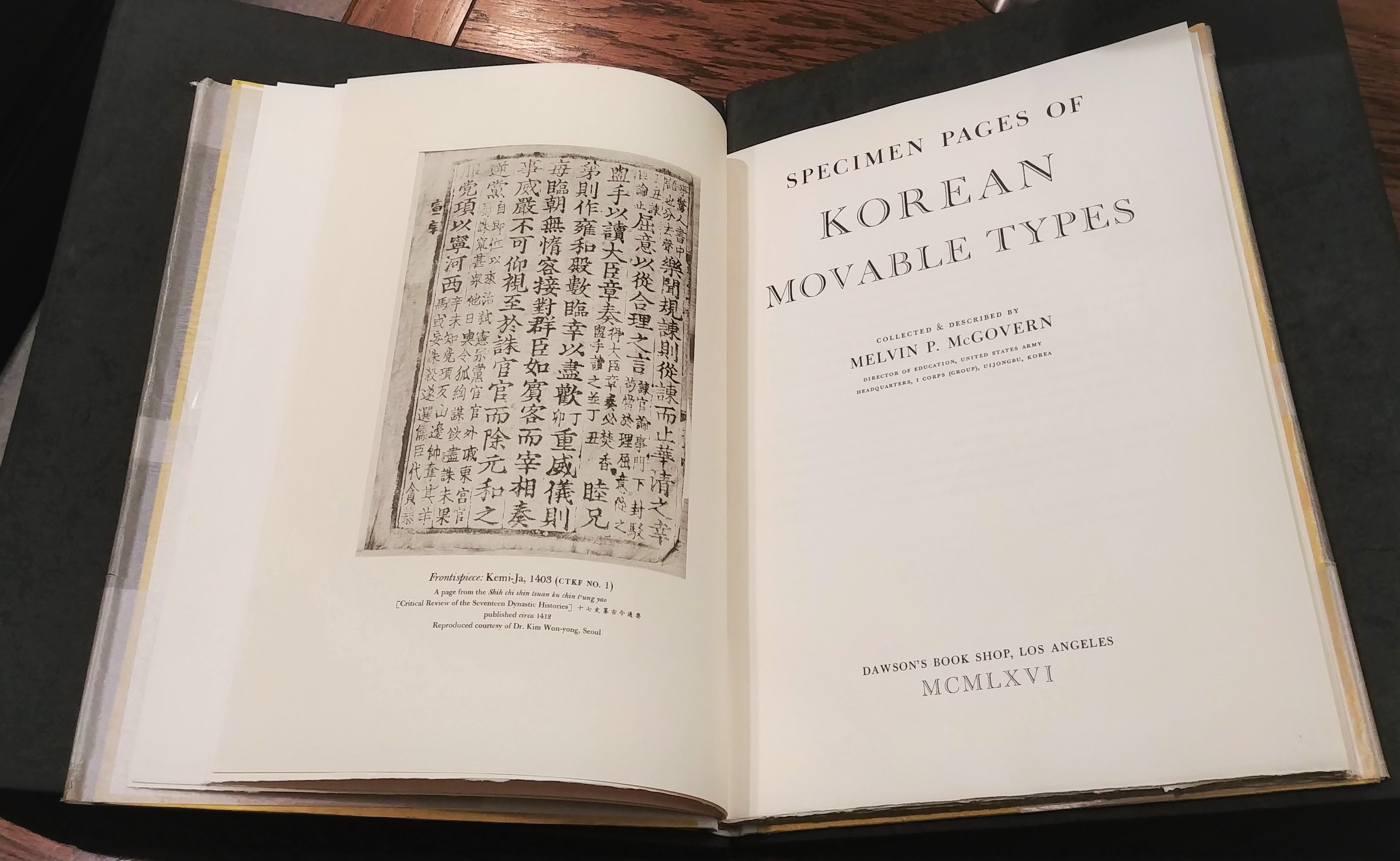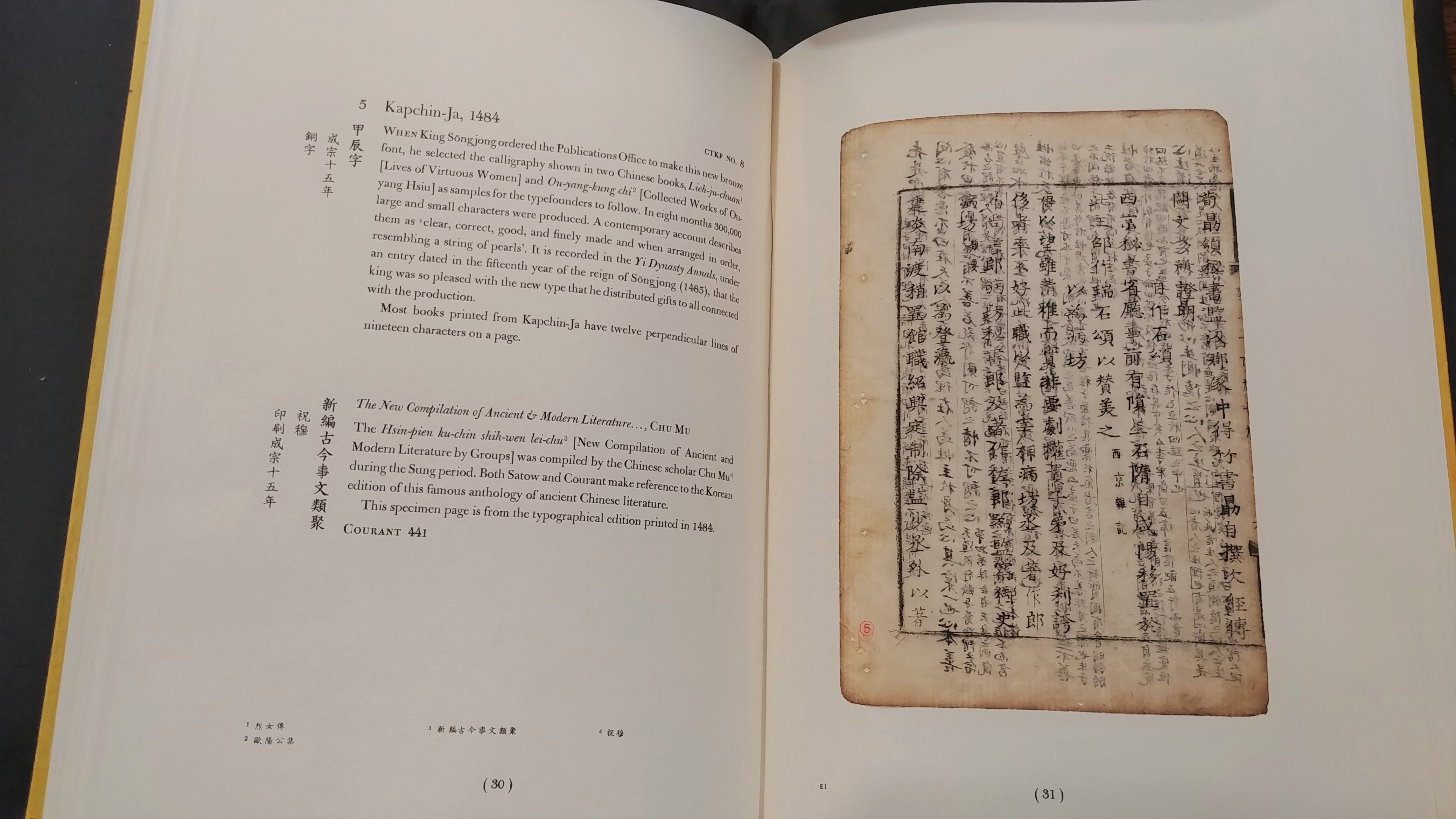
The title page and adjacent frontispiece featuring a reproduced facsimile of Kemi-Ja type from 1403. Call Number: *Z186 K67 M3

This pagespread displaying an original example of Kapchin-Ja from 1484 features notes written in a calligraphic hand on the reverse side of the printed page.

This original example page of Chaeju-Chŏngni-Ja from 1858 includes type for the Hangul writing system.
Specimen Pages of Korean Movable Types, Collected and Described by Melvin P. McGovern, 1966
This book titled Specimen Pages of Korean Movable Types was compiled and described by Melvin P. McGovern, the Director of Education in the United States Army for the I Corps group stationed in Uijongbu, Korea, and was published in 1966. With its pages printed using letterpress, the prominent folio size binding, and handmade papers, this book is not an educational text on Korean movable types, but also an amazing example of fine press printing. The specific book held in the UCLA Library Special Collections is copy number 109 out of a total of 300 copies produced. It holds a total of twenty-two type specimens, of which six are facsimiles and sixteen are original examples of Korean printing. It is a collection of type specimens that features nearly every font of Korean movable type, with the earliest being what is described as "virtually the earliest fully developed type" (McGovern 9). The author specifies that many of the specimen pages in the volume were supplied by T'ong-Mun-Kwan Bookstore, which still exists in Seoul today as the nation's oldest rare bookstore (Golden).
The various printed works range from the year 1420 to the year 1896, with each specimen highlighting a different font of Korean movable type. The book displays texts printed from Korean movable type made from various materials, including wood, bronze, and iron, to indicate the Korean preference for typographic printing and their success in producing functional movable type. The variety of the different kinds of Korean movable type also express the varied methods of Korean type production, from carving to casting type, especially as the Koreans are known to have used three different casting methods: beeswax casting, foundry sand-casting, and single-surface casting (H. Kim).
With the primary text of the book being written in English, it promotes Western access to knowing about Korean achievements in the field of printing. McGovern's accomplishments in producing this book is also well complimented by a book of type specimens produced by Son Po-gi with texts in Korean, Japanese, and English that also inform the reader about Korean movable type. The two books are not only informative resources on the development of Korean movable type, but also resemble in their outer appearance, with a bright yellow paper covering. The "Printer's Note" found on the last few pages of Specimen Pages of Korean Movable Types describe the production of the book"s embossed yellow paper cover and specify that it was dyed using a "yellow dye extracted from the blossoms of the Sophora Japonica," or goehwa namu1 in Korean.
From the precursory text and the organization of the book, McGovern makes apparent that the intention in the design of the book is to inform readers and expose them to the typographical achievement of the Koreans in developing "the world's first practical movable types" (McGovern 9). Before the Korean development of movable type, however, China is known to have created the first movable type during the Sung dynasty. This clay movable type, created by a man named Pi Sheng of the Sung dynasty, did not have much impact on Chinese printing or the developments of the Sung dynasty (W. Kim 5). Despite the available technology, block printing was historically preferred by the Chinese in comparison to type printing.2
Due to the historically smaller literate circle of Korea where "[i]n most cases fewer than 100 copies of a book were sufficient to satisfy the need [for books in Korea," the significance and rarity of McGovern's collection of type specimens is apparent, as nearly three-quarters of the specimens in the copy found at the UCLA Library Special Collections are original examples. The accomplishment of this book is further amplified, for many Korean books were destroyed along with other cultural artifacts throughout the country's history that is rife with invasion. Much of the information known today regarding works produced by Korean movable type are known through passages and notes written in extant books, such as the work Sang Jong Ye-Mun referred to in the Tong-guk I-Sangguk Jip3, in which it is written that "28 copies of the Sang Jong Ye-Mun [were] printed with "cast" type at Kanghwa-do" (W. Kim 7).
The great majority of the book is dedicated to the type samples that are pasted into the book and each type specimen page is complimented with an adjacent page of commentary explaining the details of the font and the text from which the type specimen was derived. In addition to the type specimens, Specimen Pages of Korean Movable Types includes an outline of the development of Korean printing and a chronological table of Korean fonts. The index of the work is also preceded by a "handlist" of books and articles on Korean type and printing to encourage further research on the subject.
Within the book's introductory text on the development of Korean printing is a short passage:
Maurice Courant, the famous French bibliographer of Orientalia, described in his Bibliographic coréenne a book (No. 3738) which apparently was printed in Korea from movable type in 1377. However, all efforts to locate a copy of this book or further reference to it has been fruitless. (McGovern 14)
The year 1377 is a notable year within the study of Korean movable type, as the year that the work Paegun Hwasang ch'orok Pulcho chikchi simch'e yojŏl, or Jikji was printed.4 Interestingly, this book of type specimens produced by McGovern was published in 1966, and coincidentally, Dr. Park Byeong-sun discovered an extant copy of Jikji in 1968 while working for the France National Library. This copy of Jikji contained "an inscription on the last page that it was printed with movable metal type at Heungdeoksa Temple on the outskirts of Cheongju in 1377" (Yim). Through the passage in McGovern's text, it becomes apparent that knowledge of Korean movable metal type was known by academics before Jikji was recognized as evidence of the development of Korean movable metal type. McGovern's efforts in producing Specimen Pages of Korean Movable Types created a concrete presence within the Western book collective and recorded history of printing, thus allowing for a possible shift in the way that history is portrayed within the contents of archives and special collections.
References
Ch'on-no. "Excerpt: Planning for Goehwang-Ji." Bokbokjong, Naver, 4 June 2017, www.woonup.com/up504.htm. Link leads to a website on a Korean server and may lead to a 403 Error page.
Golden, Audrey. "Buying Rare and Antiquarian Books in Seoul." ILAB, International League of Antiquarian Booksellers, 12 Sept. 2016, www.ilab.org/articles/buying-rare-and-antiquarian-books-seoul.
Hyun, Young Ah. "Movable Metal Type Printing: Korean Books from the Early 13th Century to the Early 15th Century." Gutenberg-Jahrbuch 76 (2001): 77-82. Print.
Kim, Hong-yeong. "Korea's Movable Metal Type Opens the Era of Modern Civilization." Koreana 19.1 (2005): 60-65. Print.
Kim, Won-Yong. Early Movable Type in Korea. Vol. 1. Seoul: Eul-yu Pub., 1954. Print.
McGovern, Melvin P. Specimen Pages of Korean Movable Types. Los Angeles: Dawson's Book Shop, 1966. Print.UCLA Library catalog record: *Z186 K67 M3
Son, Po-gi. Han'guk Ŭi Ko Hwalcha = Early Korean Typography. n.p.: [Seoul] : Han'guk Tosŏgwanhak Yŏn'guhoe, 1982. UCLA Library catalog record: Barcode:EE0000095026
Yim, Yumi. "The Story of 'Jikji': The World's Oldest Metal-Type Book." Templestay, volume 04, 2012, pp. 2-21.
Notes
1 The blossoms of the goehwa namu were historically used in Korea to dye goehwang-ji, a yellow paper used in Korean Shamanism practices to create charms and talismans (Ch'on-no).↩
2 This preference is often speculated by the Western academic community to be due to the large number of characters in the Chinese writing system. However, the development of movable type in Korea flourished in comparison to that in China, for "[f]rom the beginning, the Korean government appears to have preferred typographic to xylographic printing, while the Chinese, in spite of their early records of experiment in this field, continued to rely primarily on wood-block methods," despite the Koreans using the same character-based writing system as the Chinese (McGovern 13). To explain the contrasting printing method preferences of the two countries, many scholars argue that the difference results from the efficiency that block-printing provided in producing large quantities of a single book, which better served the needs of a country as populous as China, and from the flexibility that type-printing provided to produce multiple books of different texts, rather than many copies of a single book, which aligned with the smaller circle of publication circulation in Korea (W. Kim 6), (Sohn 100).↩
3 The author of this note in the Tong-guk I-Sangguk Jip fled to Kanghwa-do in 1232 when the Mongols invaded the capital of Korea and passed away on the island in 1241, and because there are no extant copies of the Sang Jong Ye-Mun, scholars can only assume that the work was printed between 1232 and 1241. This dating of the Sang Jong Ye-Mun gives rise to the possibility that this 50-volume work is the earliest known work printed from movable type, but "it is believed that movable types had already been used before the capital transfer (1232) because it seemed impossible to newly cast metal types and print the 50-volume book during the war" (Hyun).↩
4 Jikji is a book of Buddhist texts that "contains the essentials of Seon (Zen) Buddhism compiled by Master Baegun in the late Goryeo Dunasty. The book was concluded to have been printed using movable type and was listed in the UNESCO World Register in September 2001 (Yim). It is recognized as the world's oldest extant book printed with movable metal type.↩
This spotlight exhibit by Yoonha Hwang as part of Dr. Johanna Drucker's "History of the Book and Literacy Technologies" seminar in Winter 2018 in the Information Studies Department at UCLA.
For documentation on this project, personnel, technical information, see Documentation. For contact email: drucker AT gseis.ucla.edu.